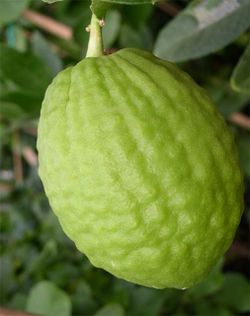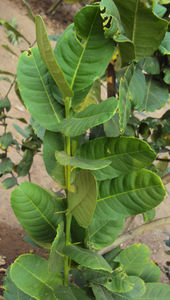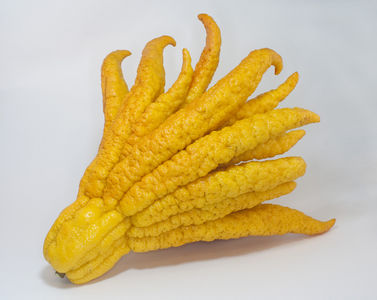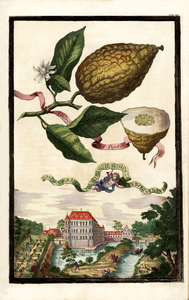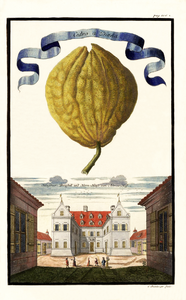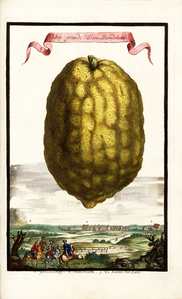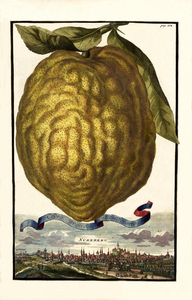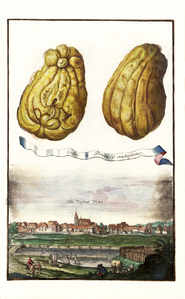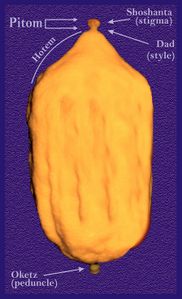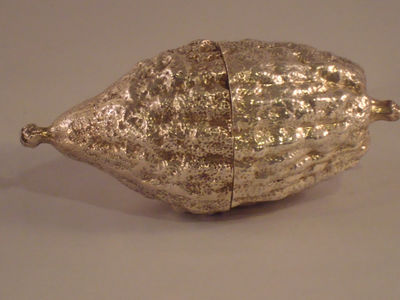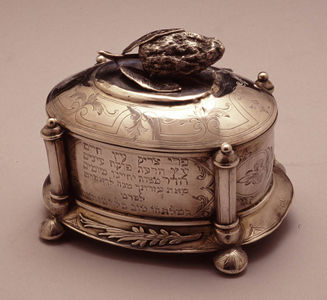Citrus medica
Citrus medica L.
| Ordre | Sapindales |
|---|---|
| Famille | Rutaceae |
| Genre | Citrus |
2n = 18
Origine : Asie du Sud-Est
cultivé
| Français | cédratier / cédrat |
|---|---|
| Anglais | citron |
- fruit odorant, surtout consommé confit
- usage rituel juif, symbolisant le juif parfait
Sommaire
Description
- arbre atteignant 3 m de haut, à écorce gris clair ; jeunes rameaux anguleux et pourpres, puis cylindriques, à épines axillaires solitaires
- feuilles elliptiques-ovales à ovales-lancéolées, de 5-20 cm × 3-9 cm, en coin ou arrondies à la base, bord denté en scie, apex pointu ou arroundi ; pétiole court, pratiquement non ailé
- boutons floraux roses ; fleurs en grappes axillaires pauciflores, de 3-4 cm in diamètre ; pétales 5, roses à l'exterieur ; étamines 30-40(-60) ; ovaire à 10-13 loges, style épais
- fruit : baie ovoïde à oblongue, de 10-20 cm long, grossièrement tuberculée ; peau très épaisse, jaune, odorante ; segments petits, à vésicules vert pâle ; jus acide
- graines nombreuses, ovoïdes, de 1 × 0,5 cm, monoembryonnées
Noms populaires
| français | cédratier / cédrat |
| anglais | citron |
| allemand | Cedrat-Zitrone, Zitronat-Zitrone |
| néerlandais | cedraat ; sukadecitroen |
| italien | cedro |
| espagnol | cidro / cidra |
| portugais | cidreira / cidra |
| arabe | الاترج ,أترج - uṭruǧ, ṭrunǧ, ṭurunǧ |
| hébreu | אתרוג - etrog |
| persan | بالَنگ، ترنج، بادرنگ - balḏak, etrog, badraḏak |
| chinois | 香橼 - xiang yuan (Flora of China) |
| sanscrit | मातुलुंग - mātuluṅga (Rasayana) |
| hindi | बारानिम्बू - baaranimbu (Rasayana) |
| telugu | మాదియఫలము - maadiaphalamu (Rasayana) |
| tamoul | கடாரனாரத்தை - kadaaranaarattai (Rasayana) |
| kannada | ಮಹಾಫಲ - mahaaphala (Rasayana) |
| malayalam | ഗണപതിനാരകം - ganapatinaarakam (Rasayana) |
Classification
Citrus medica L. (1753)
Cultivars
Histoire
Usages
- Voir les Plantes médicinales de Cazin (1868)
At the present time it is distributed in many tropical and subtropical countries, but often grown only on a small scale. The major producing areas are Italy, Crete, Puerto Rico and formerly also Corsica. The thick peel is candied, after having been cleared by fermentation in sea water. It is used as a spice (candied citron peel) in baking goods and sweetmeats. Besides this the fruits are made into marmalade, eaten in salads or are used in liqueurs. The juice of the fruits is used in beverages and desserts. The roots, flowers, fruits and their juice serve also medicinal purposes. Cultivated in SE Asia since ancient times, the citron probably has been introduced to Persia in the first half of the 1st mill. BC It reached the Mediterranean region about 300 BC at the time of Alexander the Great. This was the first Citrus species that arrived in Europe. In the 15th cent. it was introduced by the Spaniards to the New World.
Références
- Bekele-Tesemma, Azene, 2007. Useful trees and shrubs for Ethiopia. Identification, propagation and management for 17 agroclimatic zones. Nairobi, ICRAF - RELMA. 550 p. (Technical Manual 6). Voir l'article
- Chauvet, Michel, 2018. Encyclopédie des plantes alimentaires. Paris, Belin. 880 p. (p. 656)
- Dambourney, Louis-Alexandre, 1786. Recueil de procédés et d'expériences sur les teintures solides que nos végétaux indigènes communiquent aux laines & aux lainages. Paris, De l'imprimerie de Ph.-D. Pierres, premier imprimeur ordinaire du roi. 407 p. Voir sur Pl@ntUse
- Joret, Charles, 1904. Les recherches botaniques de l'expédition d'Alexandre. Journal des Savants, 498-504 et 611-620.
- Loret, V., 1891. Le cédratier dans l'antiquité. Ann. Soc. Bot. de Lyon, 17 : 225-271. doi : 10.3406/linly.1891.4867 et Persée
